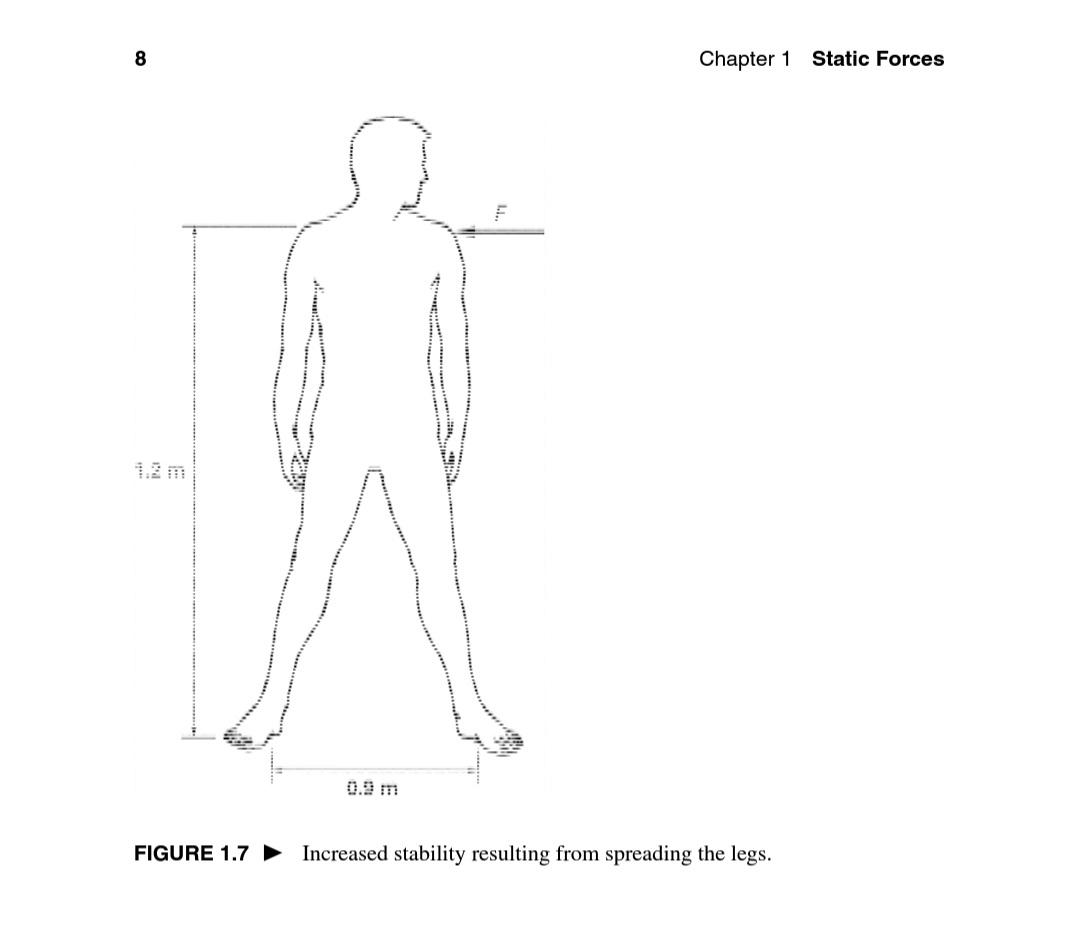(a) Explain why the stability of a person against a toppling force is increased by spreading...
Fantastic news! We've Found the answer you've been seeking!
Question:


Transcribed Image Text:
(a) Explain why the stability of a person against a toppling force is increased by spreading the legs as shown in Fig. 1.7. (b) Calculate the force required to topple a person of mass = 70 kg, standing with his feet spread 0.9 m apart as shown in Fig. 1.7. Assume the person does not slide and the weight of the person is equally distributed on both feet. 8 Chapter 1 Static Forces 1.2m 0.9 m FIGURE 1.7 ► Increased stability resulting from spreading the legs. (a) Explain why the stability of a person against a toppling force is increased by spreading the legs as shown in Fig. 1.7. (b) Calculate the force required to topple a person of mass = 70 kg, standing with his feet spread 0.9 m apart as shown in Fig. 1.7. Assume the person does not slide and the weight of the person is equally distributed on both feet. 8 Chapter 1 Static Forces 1.2m 0.9 m FIGURE 1.7 ► Increased stability resulting from spreading the legs.
Expert Answer:
Related Book For 

Chemistry The Central Science
ISBN: 978-0321696724
12th edition
Authors: Theodore Brown, Eugene LeMay, Bruce Bursten, Catherine Murphy, Patrick Woodward
Posted Date:
Students also viewed these physics questions
-
A three-phase rectifier shown in Fig. 1 has a purely resistive load of R. Justify the following equations and draw the output current (i.) and the current flown in D1 (ia) in one cycle of the input...
-
5. As shown in the figure, a well-insulated turbine operating at steady state has two stages in series. Steam enters the first stage at 800F, 600 lbf/in? and exits at 250 lbf/in?. The steam then...
-
As shown in fig 1.7, a manometer is attached to a tank of gas in which the pressure is 104.0 kPa. The manometer liquid is mercury, with a density of 13.59 g/cm3. If g = 9.81 m/s2 and the atmospheric...
-
The AND function can be realized by using only n number of NOR gates. The value of nequal to
-
David Jones has paid $16 000 for a retirement annuity from which he will receive $1375 at the end of every 3 months. The payments are deferred for 10 years and interest is 10% compounded quarterly....
-
For the year ending March 31, 2013, Omega Systems Inc. reported net income of $105,450 and paid dividends of $7,500. Comparative balance sheets as of March 31, 2013 and 2012, are as follows:...
-
Purina entered in a contract with the defendant to sell the defendant piglets, known as weanlingsbaby pigs that have been weaned. It is uncontested that the buyer breached and that Purina is entitled...
-
The bookkeeper for Andy's Country Music Bar went insane and left this incomplete balance sheet. Andy's working capital is $95,000 and its debt to assets ratio is 40 percent. Required Complete the...
-
Discuss the business benefits of adopting the relational database model within an organization. How does a relational model create or enhance business value? Are there any limitations to using a...
-
The following balances were taken from the book of JACK Partnership as of July 1, 2015 when the partnership decided to liquidate: Accounts Receivable, net Furniture & Fixtures, net Sales Proceeds...
-
A light emits red light at a frequency of 4.57 x 10 14 Hz for 12 minutes. During that time 9.32 moles of light are emitted. How many joules are emitted?
-
A company is required by legislation to undertake environmental remediation for a mining site that is currently active. The site will not be cleaned up until the mine closes, which is now scheduled...
-
Given the following table A 1 2 3 4 5 B 1 1 1 1 1 C 2 3 223 3 1. Can you find a lossless join decomposition for the table above? If yes, please write down the decomposition. 2. Suppose this table is...
-
Like a research paper, Make a background of the current Philippine tax system including its administration and imposition of tax laws. (containing facts and opinion) ?
-
Find k so that for f (x) = x + 4k x < -3 the lim f(x) exists. x-3 Do NOT include "k=" in your answer...simply enter the value e.g. 7 -2x+2 x > -3
-
Bill is single. He died in 2020 with a net estate (after expenses) of $22,000,000. How much estate tax will the estate have to pay in federal estate tax? Explain. Bob gives $10,000 to his nephew,...
-
1 . Customer Julie Jetty reached out to cancel their Jetty Deposit account as of their move out date 0 4 / 2 0 / 2 0 2 3 . They make $ 3 0 monthly payments on the 1 st of each month and were paid...
-
In Exercises 1-2, rewrite each verbal statement as an equation. Then decide whether the statement is true or false. Justify your answer. 1. The logarithm of the difference of two numbers is equal to...
-
Consider S, Cl, and K and their most common ions. (a) List the atoms in order of increasing size. (b) List the ions in order of increasing size. (c) Explain any differences in the orders of the...
-
What is the molarity of Na+ in a solution of NaCl whose salinity is 5.6 if the solution has a density of 1.03 g/mol?
-
Consider the reaction of peroxydisulfate ion (S2O8-2) with iodide ion (I) in aqueous solution: S2O82- (aq) + 3 I (aq) - 2 SO42- (aq) + I3(aq) At a particular temperature the initial rate of...
-
For coordinates \(\left(x^{1}, x^{2} ight)\) and metric \(g=\operatorname{diag}\left(g_{11}, g_{22} ight)\), the Gaussian curvature is For a sphere with coordinates defined in the following figure,...
-
Consider the holonomic basis defined in Box 26.1 . Using that the tangent vector for a curve can be written \(t=t^{\mu} e_{\mu}=\left(d x^{\mu} / d \lambda ight) e_{\mu}\), show that Thus, \(g_{\mu...
-
The Lie bracket of vector fields \(A\) and \(B\) is defined as their commutator, \([A, B]=\) \(A B-B A\). The Lie bracket of two basis vectors vanishes for a coordinate basis but not for a...

Study smarter with the SolutionInn App



